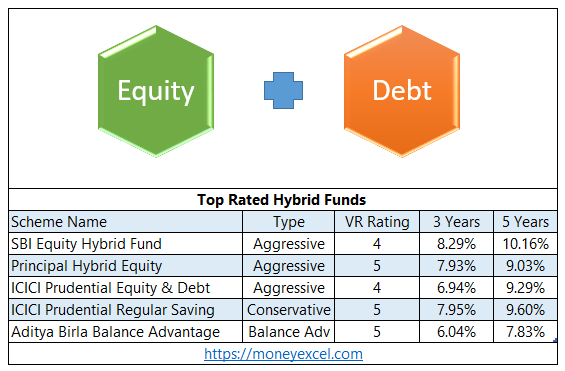Hybrid means a mixture of two or more elements. Similarly, Hybrid funds mean a combination of equity as well as debt instruments. As the hybrid fund is a combination of equity and debt, investors get benefit both investment instruments in a single product. Equity offers capital appreciation & debt offers stability with safety. It is one of the best ways to diversify your mutual fund portfolio. If you are a moderate risk-taking investor you should opt for hybrid funds. In this article, I will cover- How hybrid funds work? Who should invest in Hybrid fund? Type of Hybrid funds & Top rated hybrid funds in India.
How Hybrid Funds work?
Hybrid funds work on asset allocation fundamentals. Every hybrid fund scheme has an objective. The objective could be generalized in terms of generating long term capital growth by investing in equity and debt or it could be mentioning a range of asset allocation in equity as well as debt instruments.
The fund manager of the fund allocates your money based on the allocation defined into fund objective. The investment will be made in equity as well as debt money market instruments and government bonds. The fund manager tries to create the right balance between equity and debt. The role of the fund manager in this fund would be taking buy & sell calls based on the market conditions. If the stock market falls fund manager will reduce equity exposure and if the stock market is bullish fund manager increase equity exposure. The prime idea is to generate higher returns.
Also Read – Top 20 Best Mutual Funds SIP to invest in India for 2019
Type of Hybrid funds
As per SEBI guideline, there are seven different types of hybrid funds.
Aggressive Hybrid – Aggressive hybrid fund invests 65-80% of its assets in equity instruments. As investment in equity is higher this type of hybrid fund is riskier compared to all other hybrid funds.
Conservative Hybrid – Conservative hybrid fund invests more than 70% of its assets in debt instruments. This type of fund is suitable for conservative investor as risk level is very low.
Balanced Hybrid – In this type of fund exact balance between equity and debt is kept. This means 50% of fund amount will be invested in equity and remaining in debt.
Balance Advantage – Balance Advantage fund is also known as dynamic asset allocation fund. In this fund allocation is dynamic based on the market condition. This means equity investment can be very high in bullish market condition and can be very low in bearish condition. The allocation is not fixed.
Multi Asset Allocation – Multi asset allocation is unique fund where investment is made in multiple asset class such as equity, debt as well as gold. The mandate in this fund is to invest at least 10% of its assets in a minimum of 3 separate asset classes.
Arbitrage – I call arbitrage as complex fund where fund manager buys shares in cash market and sells it in futures or derivative market. You should get complete understanding before opting for this fund.
Equity Saving Schemes – Equity saving scheme invests minimum 65% in equity investment, 10% in debt and remaining in arbitrage opportunities. It is called as equity saving scheme for taxation purpose.
Top Rated Hybrid funds to Invest in India
I have tried to shortlist 5 Top rated hybrid funds to invest in India based on their long term returns and asset allocation strategies.

Note – Rating and returns are as on Aug, 2019.
Who should invest in Hybrid fund?
Hybrid fund is suitable for the beginner as well as seasoned investors.
As discussed above there are multiple types of hybrid funds available in the market. One can invest in the fund based on risk profile and investment objectives.
New Investors – It is a very good idea for the new investor to enter in the mutual fund world via hybrid fund route. As a new investor if your risk taking capacity is low you can opt for conservative hybrid, balance hybrid funds.
Seasoned Investor – A seasoned investor can also invest in hybrid mutual funds based on risk appetite and investment objective. If your risk taking capacity is moderate you can go for balanced hybrid, balance advantage or multi asset allocation. If you have high risk taking capacity you can opt for aggressive hybrid fund, arbitrage or equity saving scheme.

